A major part of Australian home design is the seamless connection of indoor and outdoor spaces for the ultimate entertainment and living zones. With a growing trend towards indoor-outdoor living, home builders are designing and building homes incorporating functional living areas that bridge the gap between indoors and out. No longer is the home and garden considered two separate entities with a strict boundary. Your outdoor space literally becomes an extension of the living area, kitchen, dining, or entertainment zone. The central principle is to create a fluid transition so the indoors and outdoors feel like one zone, whether through custom building, removing an existing wall, adding glass, or feature doors. In this article, discover the benefits of indoor-outdoor living, the types of indoor-outdoor spaces, and 16 fabulous ways to connect your indoor and outdoor space for the ultimate entertainer’s home.
Connecting Indoor & Outdoor Spaces
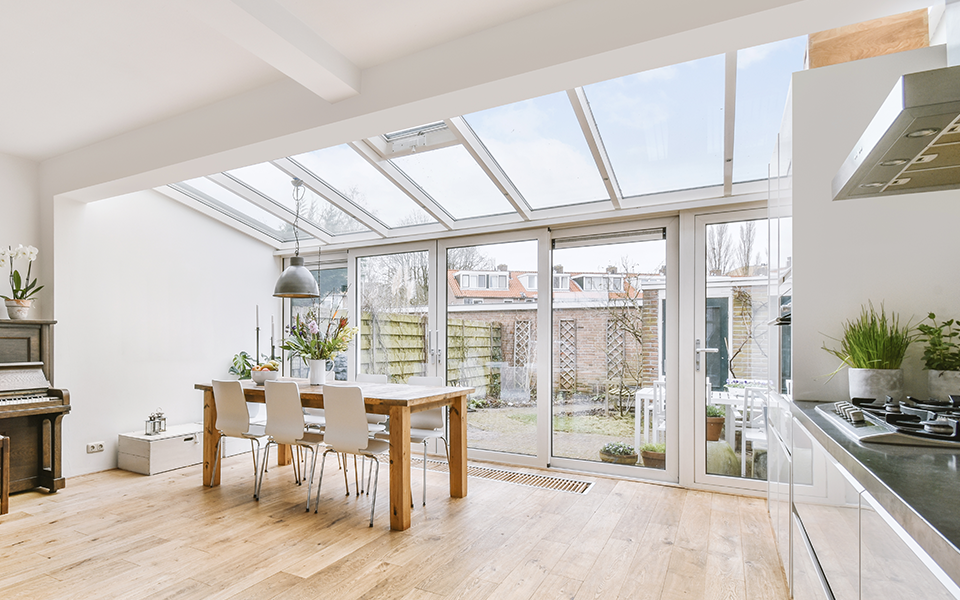

Connecting Indoor & Outdoor Spaces

Benefits of Indoor-Outdoor Spaces
The growing tendency for homes with indoor-outdoor living has been noticed worldwide. Not only does an indoor-outdoor zone look beautiful, it is also reputed for its health and wellbeing benefits. Check out the plethora of benefits of an indoor and outdoor space.
- Expanded living area. The most obvious benefit is, of course, the extra space. Connecting an indoor and outdoor space means you basically double or triple the living and entertainment area. You have more options for entertaining and can host extra guests with the expanded living area.
- Increased home value. A functional outdoor living space connected to the indoor area is a major drawcard for prospective buyers. While the home’s value depends on the square meterage, an attractive indoor-outdoor area can add thousands of dollars in value. When it comes to upgrading your home, adding outdoor features is one of the best ways to increase the home’s value. Buyers love seeing a fabulous outdoor kitchen or relaxing outdoor lounge.
- All-year outdoor entertainment. As most indoor-outdoor spaces are covered, another benefit is year-round outdoor living and entertainment. Even if it is raining, you can still enjoy the outdoor kitchen or cosy up to the outdoor fireplace.
- Increased natural light. Connecting indoor-outdoor areas with more glass, bifold doors, or removing walls produces well-lit spaces with increased natural light. Not only do these large spaces look appealing, but the natural light can help reduce energy consumption as there is less need for artificial lighting.
- Health benefits. Being outdoors has significant health benefits, including better cognition and memory, reduced stress, better breathing, and better sleep. The fresh air and natural light do wonders for your health, improving emotional well-being and boosting energy levels.
- Bring nature inside. Feeling connected to nature is good for the mind and spirit, and indoor-outdoor spaces allow nature to be more incorporated into everyday life. Whether sitting outside or looking at nature through glass doors or an open wall, any exposure to natural elements is known to boost happiness.
Types of Indoor-Outdoor Spaces
Homes of every size and style can feature integrated indoor and outdoor spaces, from a small courtyard with bi-fold doors to an opulent sunken lounge and infinity pool. Even a cosy connected outdoor space will help an interior to feel larger.
Indoor-outdoor living comprises everything from large decks and balconies flowing from inside the house to pergolas, paved courtyards, and indoor / outdoor kitchens, to name a few. The following are some examples of types of indoor-outdoor spaces.
Indoor lounge and paved patio
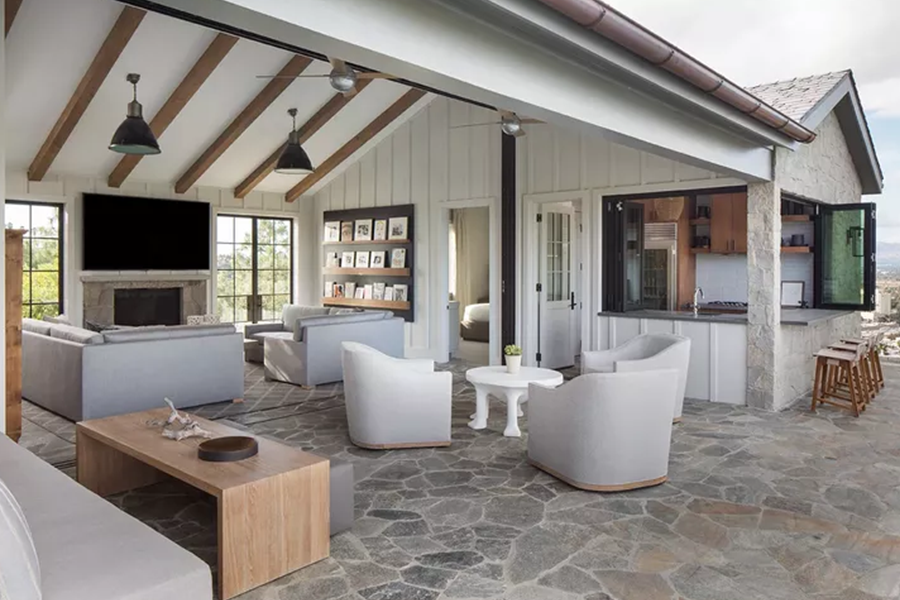
Source: Mark Langos Interior Design / Meghan Beierle-O’Brien
This indoor lounge and outdoor patio is a good example of an indoor-outdoor space with a seamless transition through the removal of the main wall and the continuation of the same flooring materials.
Indoor-outdoor kitchen
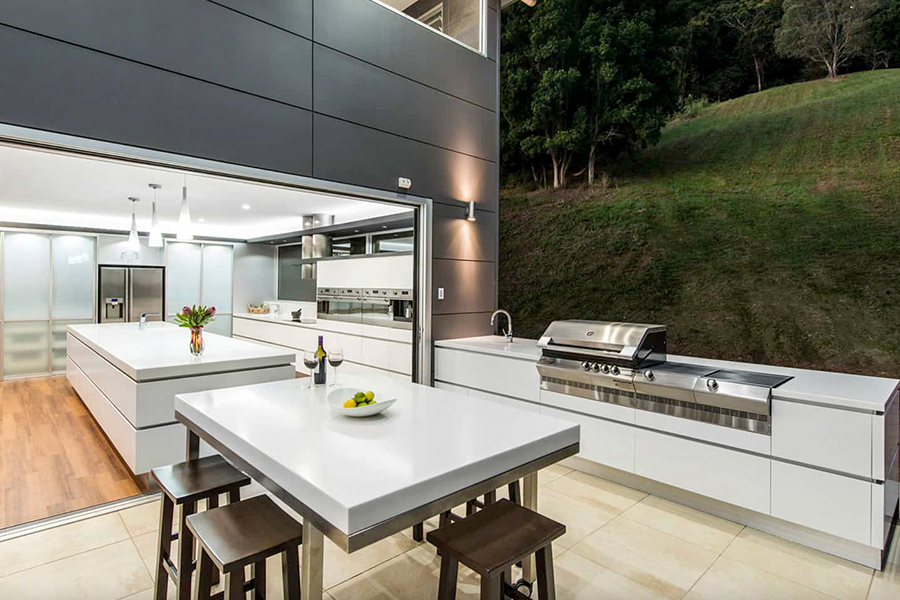
Source: Sublime Architectural Interiors / Houzz
This indoor-outdoor kitchen doubles the cooking and dining facilities. The fluid transition from inside to out is achieved with the glass sliding doors, mirrored layout, and complementary palette.
Indoor kitchen and decked dining
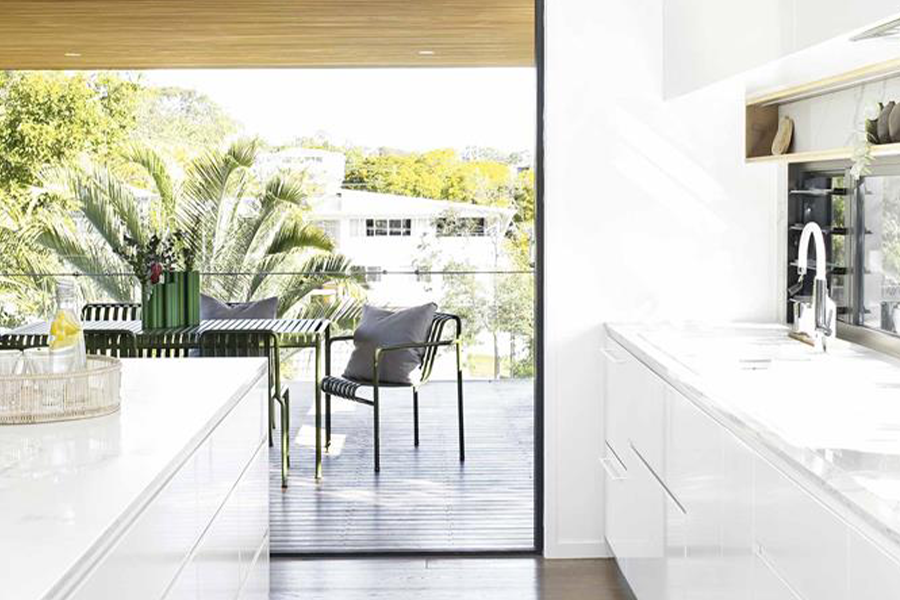
Source: Big House Little House / Anastasia Kariofyllidis
Wall-sized glass doors blur the boundaries between the inside kitchen and outdoor dining, another example of the different types of indoor-outdoor spaces.
Indoor dining, outdoor lounge, fire pit, and pool
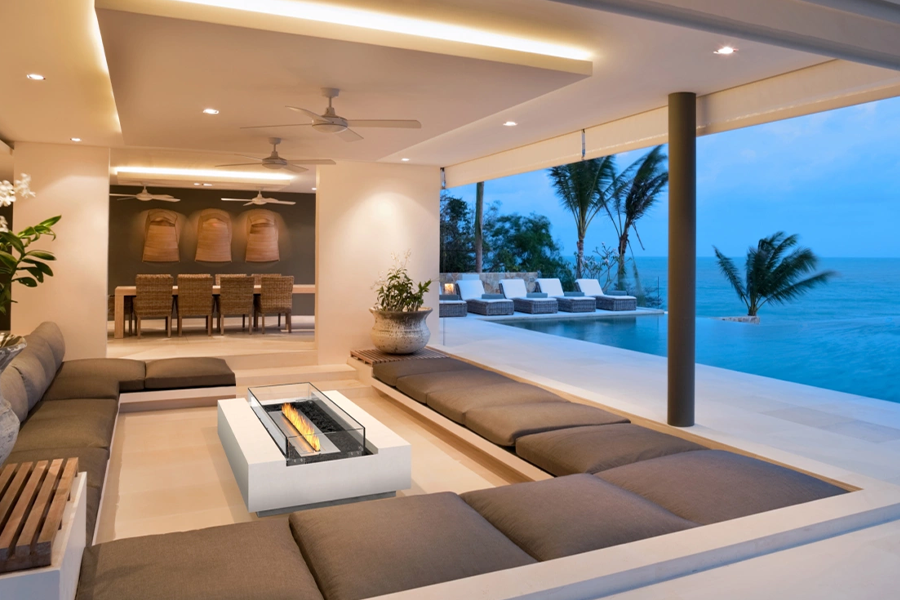
Source: MAD Design Australia / EcoSmart Fire
This open indoor and outdoor area is under the same roofline with a sunken lounge and fire pit, overlooking the infinity pool and views for the ultimate example of indoor-outdoor living possibilities.
16 Ways to Connect Indoor & Outdoor Spaces
You can create an indoor-outdoor connection in many ways, from choosing materials to extending the roofline and knocking out windows and doors. With clever stylistic influences and modern functional integrations, you can blur the boundaries between indoor and outdoor spaces to create a stunning indoor-outdoor setup. Check out the 16 ways to connect indoor and outdoor spaces.
Functional Integrations
- Extend the roofline. Having a continuous roofline from the inside living area to the outdoor space creates a seamless transition from the interior to the exterior of the home. The roof is typically attached to the outside wall of the home with posts or walls at the other end for support. Extended rooflines can be used on pergolas, decks, patios, and balconies or factored into a custom-built design. The roofline can be in the same roof materials as the home or using shade shutters, retractable canopies, and vergolas. Materials often used for outdoor roofs include metal, fibreglass, and concrete tiles.
- Use glazing. Glass is an effective way to visually connect the indoors and outdoors. A large glass picture window or a corner window can provide unobstructed views of the garden and outdoor area, while a glass roof or skylight will let in loads of natural light. Using glass bifold or sliding doors is the ideal way to create a harmonious indoor-outdoor connection, removing the visual and physical barrier between the two zones.
- Create large expansive door openings. A large expansive door opening creates an instant connection to the outdoors, provides ventilation, and enhances natural light. Huge door openings are ideal for several different doors, including bifold, sliding, large pocket doors (a sliding door that disappears into a compartment in the adjacent wall when fully open), and French doors. If you are after something unique, there are the less common vertical doors that open upwards with a wheel or mechanism, or large glass garage doors that open vertically with the push of a button. Alternatively, pivot doors are great for the ‘wow’ factor. This swinging door that rotates on a spindle is used mainly in designer homes and can be made much larger than traditional hinged doors.
- Remove a wall. Removing a whole wall or part of a wall is a great way to open up the house to the outdoor living area and add space, beauty, and function to the room. Solid walls can be replaced with one you can see through, whether a huge sliding door or glazed windows, to bring in more light and create a better flow. When knocking down an exterior wall, it is vital to seek professional advice to ascertain the work and permits required.
- Use the same flooring inside and outside. Using the same flooring throughout the indoor and outdoor areas creates the effect of one large continual space and blurs the boundaries between the zones. When choosing flooring for indoor and outdoor applications, choose either the same materials or different materials with the same colour tones. Popular materials for indoor-outdoor living are timber, concrete, natural stone, and tiles. Make sure tiles are non-slip.
- Maintain the same floor level. Create a fluid transition from the interior to the exterior with the same floor level so that there is no step up or down when going out or in. An even floor level looks great but also reduces the clear line between the indoors and outdoors, giving the feeling of one unified room when the doors are open. (Additional compliance levels may be required to achieve this).
- Use the same construction materials. Boundaries can be dissolved between the interior and exterior by using the same construction materials throughout. If you have a timber home, continue the timber to the outside area with an outdoor feature wall. Alternatively, use a stone firepit to complement a feature stone wall in the home. Natural construction materials like timber, concrete, and stone are ideal for both indoor and outdoor spaces and can be weatherproofed for the outdoor area.
- Continue the same architectural style. Continuing the same architectural style throughout the interior and exterior enhances the connection between the two zones. If you have feature arches inside the home, continue the arch theme outside. If your home is minimalistic, aim for a minimalistic outdoor area. If your home has thick timber beams, continue the beams outside for a streamlined effect.
- Add glazing to a bathroom/bedroom. On a smaller scale, you can connect indoors and outdoors simply by creating a garden outside the bathroom or bedroom. Using the same principles as larger living rooms, a large picture window or even glass doors will connect the interior and exterior.
- Add glass walls and a roof to a hallway. A creative way to connect the interior and exterior is by converting a passageway into a glassed atrium. The extra dose of natural light will flow through to adjoining rooms.
- Install a two-sided fireplace. With a two-sided fireplace, one side faces the outdoors and the other inside, connecting the two spaces. Glass fireplaces also act as a window connecting the interior and exterior.
- Make the outdoor kitchen an extension of the indoor kitchen. There are several ways to create an indoor-outdoor kitchen. By installing a large bi-fold window into the kitchen and adding a window sill bench, you have extended your kitchen area to the outdoors. You can also remove the kitchen wall and install bifold doors to the outdoor dining area. Alternatively, add glass sliding doors and install a long run of cabinets spanning from inside to outside for one continuous bench that expands the kitchen area to the outdoors.
- Link indoor entertainment to the outside. To enhance the flow from indoors to out, link the home’s entertainment system. Connect your outdoor TV and audio speakers to the home’s wifi, and you can have unified music from inside to outside.
Stylistic Integrations
- Use the same colour palette inside and out. Using the same colour palette throughout the indoor and outdoor living space creates a sense of connection. By introducing your interior colour scheme to the outdoor area with elements like cushions, throw rugs, and pot plants, you can create a harmonious flow that blurs the boundaries. You can also create a connection by decorating the indoor and outdoor tables in the same style.
- Continuity with lighting. Lighting is an important factor in the connection between the two spaces and needs to be considered in the planning of the indoor-outdoor space. If you have downlights inside the home, consider continuing them outside. Use outdoor lamps if you have lamps in the living room, and consider feature lighting for paths, swimming pools, and plants. Outdoor kitchen benches look great with countertop lighting and ensure workstations and corners aren’t left in the dark.
- Introduce greenery inside as well as out. Adding plants to the inside of the home can create a further connection to the outdoors. Decorate the indoors with a few scattered potted plants and outside with one or two for continuity. A potted palm inside and outside, for example, will create a united aesthetic and create a seamless transition between the spaces.
A strong indoor-outdoor connection fills your home with light and makes it feel more spacious. Your outdoor area becomes an extension of the interior to be enjoyed all year round. A home that incorporates outdoor living is not only beautiful but is great for our health and wellbeing. Whether designing a new home or renovating an existing property, the goal is seamlessly transitioning indoors to outdoors and encouraging flow between the spaces. From incorporating glazing, opening walls, and extending the roofline to material continuity, fabric and lighting choices, you can create a harmonious indoor-outdoor connection to enhance the enjoyment of life in the home. To find out how to maximise your indoor-outdoor space, contact the experts at Forme Homes today.

